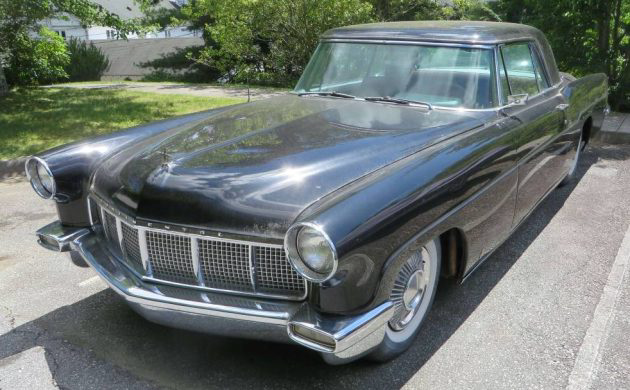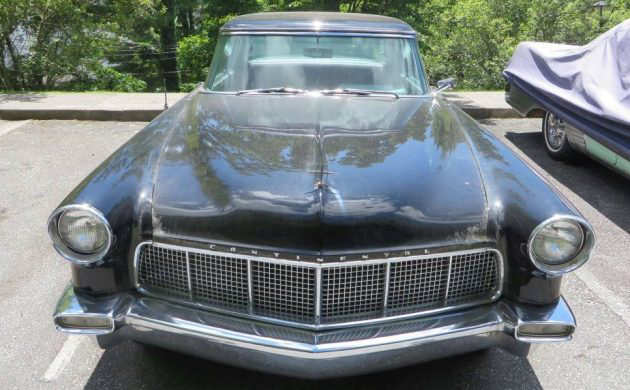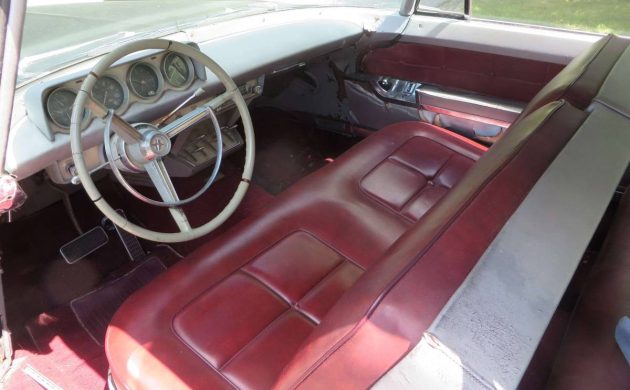Offers Considered: 1956 Continental Mark II
Halo models are not a new phenomenon, and are almost as old as the automotive industry itself. However, halo marques are less prevalent, and typically occupy the upper end of the market to entice “Joe Average” into a showroom as an opportunity to sell a more mainstream model. The Ford Motor Company pursued the halo marque path with its Continental Division, a short-lived endeavor that eventually drove a wedge between Henry Ford II and his brother William. Our feature car is a 1956 Continental Mark II which was a money-is-no-object exercise in excellence. It runs and drives, and while the seller sets a price for this classic, they may consider offers from individuals wishing to return this classic to its former glory. I must say a big thank you to Barn Finder Rocco B. for spotting this fantastic project candidate.
The aim of the Continental exercise was quite noble, with the Ford Motor Company viewing it as an attempt at automotive excellence. The company wanted to produce the best car in automotive history, hoping that the public would view the build quality as typical of every marque within the Ford empire. The sticker price was staggeringly higher by the standards of the day, but Ford still lost money on every sale. The first owner ordered this Continental in Presidential Black, one of the nineteen colors available on the Mark II palette. Interestingly, Continental never offered Metallic paints, holding grave doubts about the longevity of such finishes. The presentation of our feature car is acceptable for a survivor, with the paint holding a healthy shine. However, there is evidence of checking and other shortcomings that might motivate the new owner to consider a cosmetic refresh. I can’t spot any rust in the limited listing images, but climbing underneath would be worthwhile to confirm the floors and trunk pan are solid. Both are known weak spots that can be expensive to repair. The trim looks acceptable for a driver-grade build, and there are no apparent glass issues.
This frontal shot is as close as we come to seeing what is under this Continental’s hood. The company adopted a “one size fits all” philosophy with the specifications, with every car featuring the 368ci Y-Block V8, a three-speed automatic transmission, and power-assisted steering and brakes. The V8 generated 285hp and 402 ft/lbs of torque in its prime, allowing the Mark II to touch 123mph. Therefore, cruising at 70 was child’s play for these classics. The seller indicates that this Continental runs and drives, but doesn’t categorically state whether it is roadworthy. However, these aren’t mechanically sophisticated vehicles, and if it has mechanical shortcomings, addressing them in a home workshop might be possible.
I would use the word “serviceable” to describe this Continental’s interior. It doesn’t require a complete retrim, but certain aspects would benefit from a refresh to lift the appearance. The front seatcover looks good, although there are no shots of the back seat or headliner. There is visible carpet wear and physical damage to the door trims and kick panels. Replacement parts are available, but they aren’t as cheap as you will find on many classics from this era. There are no aftermarket additions, and the only available option in 1956, which this car doesn’t feature, was air conditioning. Otherwise, the Mark II was considered exceptionally well-equipped for its time. Buyers received power windows, a power front seat, a power antenna, plush interior and trunk carpet, a Travel-Tuner AM radio with twin speakers, and a self-regulating clock.
Although halo marques are uncommon, they still exist today. Bugatti is one of the more extreme examples, falling under the umbrella of the Volkswagen Group. Its Veyron model pushed the boundaries of automotive engineering to extremes when it hit the market, and despite a seven-figure price tag, Volkswagen lost a staggering $1,000,000 on each sale. Continental wasn’t that extreme, but it did lose approximately $1,000 on every Mark II that left the factory. This was considered unsustainable for a company that was no longer solely in the hands of the Ford family. The decision to ax Continental caused a rift between Hank the Deuce and William Clay Ford, and that never genuinely healed. This 1956 Mark II needs a new home, with the seller listing it here on Craigslist in Blowing Rock, North Carolina. They set their price at $20,000, although they will entertain offers. Would you pay the full amount, or do you have a lower figure in mind?
Auctions Ending Soon
 2006 Ford Mustang Saleen S281 SCBid Now10 hours$15,000
2006 Ford Mustang Saleen S281 SCBid Now10 hours$15,000
 2002 Subaru Impreza WRXBid Now3 days$333
2002 Subaru Impreza WRXBid Now3 days$333
 1975 Chevrolet Corvette ConvertibleBid Now3 days$3,000
1975 Chevrolet Corvette ConvertibleBid Now3 days$3,000
 1964 Ford F-100 Camper CustomBid Now3 days$2,000
1964 Ford F-100 Camper CustomBid Now3 days$2,000
 2006 Jeep Wrangler SportBid Now5 days$10,500
2006 Jeep Wrangler SportBid Now5 days$10,500






Comments
There is rust on the gearshift lever. That’s reason for concern.
That does seem odd. Leak in the roof above? But it was a hand built car and used many parts that were unique. Maybe quality control slipped on the shift lever? I do lust after these until I remember reading someplace, maybe here, that the hubcaps were hand made from two pieces and nowadays cost six hundred dollars to replace. Imagine hitting a curb with one, ouch.
Fox owner, I heard of owners keeping the wheel covers of these Continentals keeping them locked away in their trunks. Some used another type of wheel cover as a cheaper backup, or substitute, but can’t remember which ones those were. At $3k for a set of wheel covers, I’d be pricing some locking Coker wire rims instead.
At the bottom of the rear window, looks like a rust hole. Also appears to have blue masking tape on the passenger window frame/gap. Water intrusion very probable. Hopefully not too much damage as a result.
No engine pics on this level classic? I drool every time I see a Mark11 listed here. I’m sure brakes need work and wonder if these 2 yr only Continentals parts were interchangeable with other easier to source Ford parts. I know these drums are massive. No AC in a black car in the South would have to be updated.
I got a chance to take one of these on a short test drive back in the mid 80’s. Same colour combination as this one. Very easily kept up with highway traffic of the day. Maybe not with today’s aggressive drivers though. Through the bumper exhaust was a very cool feature.
I drove one too many years ago. What I remember of it was the vague steering on the freeway. Very disconcerting.
I always slobber when the Mark11s become available on BFs. The closest I can get Is a 65 Mercury Marauder, but I love it. And this one in NC is close, so dangerous to look at here.
I remember when these came out, thinking that the coupe style threw the proportions so far “off”: these SCREAMED to be FOUR DOORS! This one plainly is a “survivor”, but clearly has had “problems”. Rust holes and leaking windows with tape are situations of which I want no part. These used to bring BIG BUCKS; however, at what seems like a near-cheap cost to buy, this example is no bargain. These had all of the quality-control issues of a one-off: a must to avoid. When it comes to owning a classic car, RELIABILITY and mostly trouble-free operation are Job #1. And if you have to triple your money to make it truly road-worthy, even in a driving rainstorm, I’ll pass; ask you!
Hey Harrison Reed. Can you imagine a coachbuilder making a four door of one of these? What a project that would be. Of course, you’d have use an unsavable donor or risk spending your afterlife suspended from a barn door with a rusty spike through your privates. But what a car, what a car!
I remember when these came out, thinking that the coupe style threw the proportions so far “off”: these SCREAMED to be FOUR DOORS! This one plainly is a “survivor”, but clearly has had “problems”. Rust holes and leaking windows with tape are situations of which I want no part. These used to bring BIG BUCKS; however, at what seems like a near-cheap cost to buy, this example is no bargain. These had all of the quality-control issues of a one-off: a must to avoid. When it comes to owning a classic car, RELIABILITY and mostly trouble-free operation are Job #1. And if you have to triple your money to make it truly road-worthy, even in a driving rainstorm, I’ll pass; ask you!
I have one of these in similar condition (mine might be a little better because there’s no rust but needs paint). Mine has been sitting for several years because I have too many car projects. Mechanically though they are pretty normal Ford for the most part and a lot of the parts are interchangeable with Thunderbirds of the same era. The vacuum lines keep going and going though. The Mark II-specific trim is no small cost though. I had to replace the ring around the headlight shortly after I bought it and it was over $400 for a used, driver-quality one with some minor pitting and that was ten years or so ago! Beautiful cars though and got lots and lots of looks when I had it up and running!
I like a lot of you lust after these. This one might be a good one, but I wouldn’t even consider it without a full in person inspection. Too many surprises could break the bank, very quickly.
This is still my favorite car of the 1950’s period and by it being here in my home state it makes even more desirable.
I owned a black 1856 with heather fabric interior. I bought it from original owner in 1993 with 33,000 miles on it. And yes, I, too, removed the hubcaps and replaced them with later model ones for driving around town. (I did so at the suggestion of folks in the Continental owners club…) The MSRP in 1956 was around $10,000 which was a helluva lot of money considering that a 1957 Chevy Bel Air Convertible was around $2,600 new. It was great fun.
To be clear, my car was 1956 model year, not an 1856 model year!
$10,000 in 1956 is about $116,000 today. That helps puts this car in context.
OH YEAH a swell car , had I not bought my 54 buick I would have this problems and all.
I have owned Cadillac’s and Imperials but never a Lincoln but do like the song
https://www.youtube.com/watch?v=MBUfNxfc2w4
Seller must not be very motivated to sell, he posted only a few photos. Unless they is something(s) that he doesn’t want prospective buyers to see.